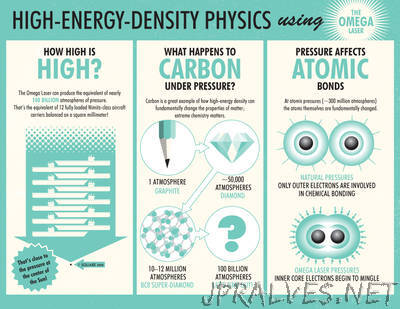
“Atoms behave much differently when squeezed to pressures more than a million—or even a billion—times the atmospheric pressure on Earth. Understanding how atoms react under such high-pressure conditions can lead to the creation of new materials and give scientists valuable insights into the make-up of stars and planets, as well as the universe itself. Those are among the reasons the University of Rochester has turned its attention to the relatively new field of high-energy-density physics. Another reason is that the University is well poised to make major contributions to the field. “Our people and our resources put us in a unique position to gain crucial insights in the field of high-energy-density physics,” says Provost and Senior Vice President for Research Rob Clark. Rochester’s Laboratory for Laser Energetics, for example, is home to the OMEGA laser. At 10 meters tall and 100 meters long, the OMEGA is the world’s largest university-based laser. Rochester has also recruited Gilbert “Rip” Collins to lead a new, multidisciplinary research initiative for high-energy-density physics. Collins was previously the director of Lawrence Livermore National Laboratory’s Center for High-Energy-Density Physics, and is now professor in the Department of Mechanical Engineering and the Department of Physics and Astronomy, as well as senior scientist at the University’s Laboratory for Laser Energetics. Collins says the initiative “will make it easier to collaborate between chemistry, engineering, physics, and astronomy,” leading to faster advances in the field. Collins studies, among other things, how atoms bond under conditions of extreme pressure. Typically, it’s the outermost electrons of an atom that react with the electrons of other atoms. But when the pressure on the atoms is greatly increased, the inner electrons get involved, and that’s when the fun begins.”
